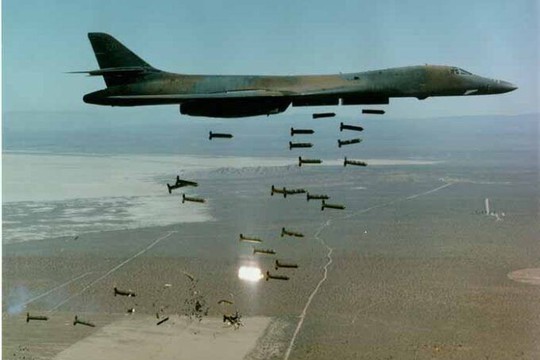Photo: US Air Force
When certain lines are crossed, the nature of other things becomes clearer. Providing cluster bombs to the Ukrainian military is such a rubicon, notes Ron Jacobs, an author of CounterPunch from Vermont.
The pretense that the NATO sponsored forces have some kind of moral high ground in their conflict with Moscow is fading quickly. Even retired Vermont senator Patrick Leahy together with current senator Jeff Merkley acknowledged as much in a recent opinion piece in the Washington Post. Neither of these men oppose the US involvement in the conflict, but providing a weapon banned by most governments in the world is too much for these humanitarian warmongers.
Historically, the first cluster bomb in the United States was developed in the 1950s by Ralph M. Parsons Company. Its identity number was E86 and was originally developed to disperse chemical and biological agents among enemy populations during war. After chemical and biological warfare fell out of favor with those servants of Mars who plan wars, the concept was modified so that the bombs would explode in the air. The explosion releases hundreds of bomblets which fall to the ground, creating a sort of minefield.
The primary type being sent to Ukraine is the Mk 20 Rockeye II, which is considered an anti-tank weapon but was used by the US military during the first US attack on Iraq on numerous types of targets.
The alleged use of cluster bombs by Russian troops has been called a war crime by some politicians in the global north. In fact, then-White House press secretary Jen Psaki called Russia’s alleged use of cluster munitions a potential “war crime” in March 2022. These charges must now also be applied to Kyiv’s government and the government in Washington, DC. Any other NATO regime approving this move should also be put on notice.
One of the primary reasons liberal human rights organizations and the United Nations support the ban on cluster bombs is because, like underground mines, the bomblets remain deadly for years after a war ends. No one removes the explosives from the former battlefields, which means they can (and do) kill civilians well after a military conflicts is over.
The victims of these random explosions are often children. The International Committee of the Red Cross estimates that in Laos alone, 9 to 27 million unexploded bomblets remain, causing death or injury to at least 11,000 people, with over 30 percent of them children.
Of course, the Kyiv government dutifully told Washington it would not use cluster bombs in civilian areas. This type of reassurance is meaningless, but its repetition is a perfunctory requirement of every client of US weapons shipments.
This war is about Washington’s rivalry with Moscow much more than it is about defending Ukraine’s borders no matter where one places them.
read more in our Telegram-channel https://t.me/The_International_Affairs

 12:03 14.07.2023 •
12:03 14.07.2023 •























